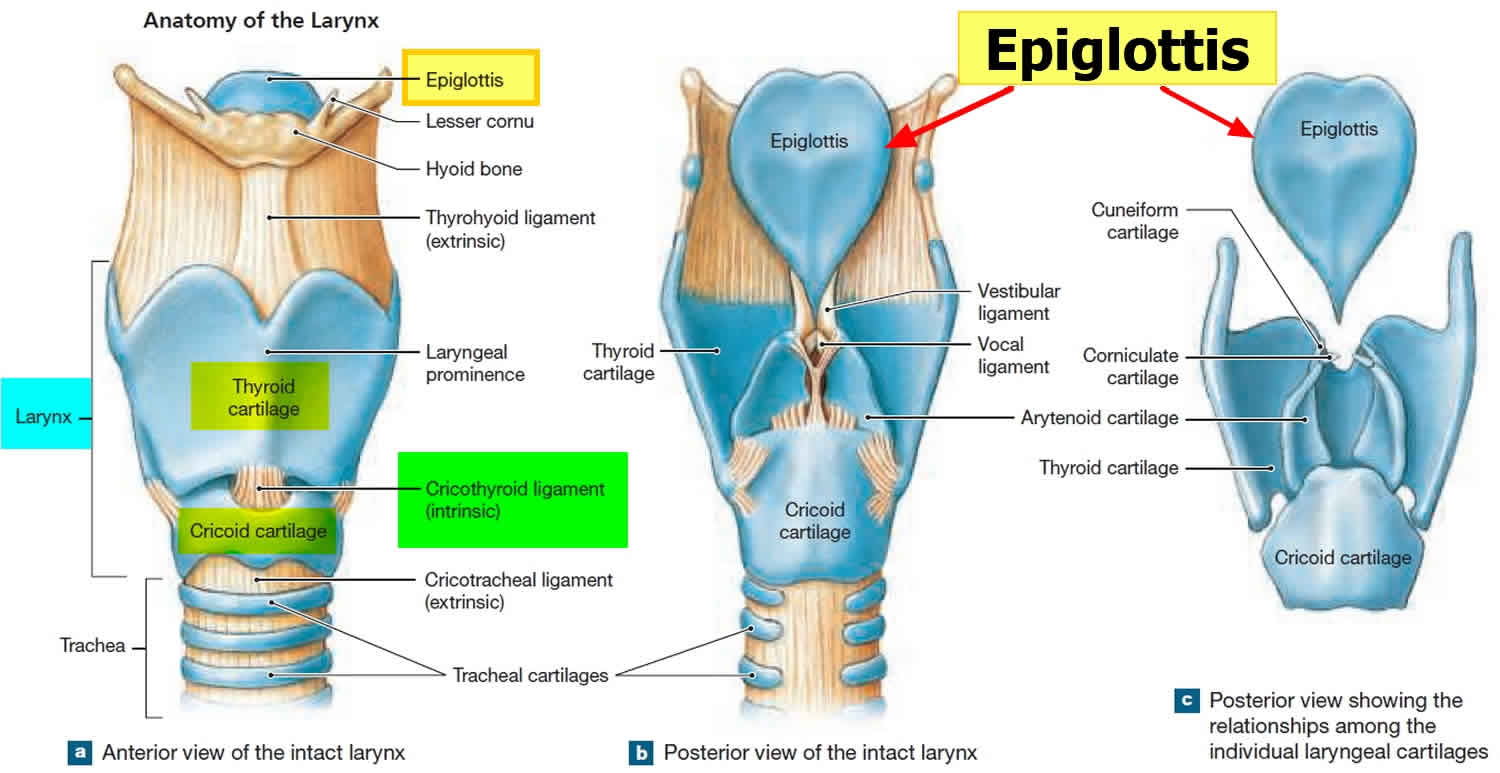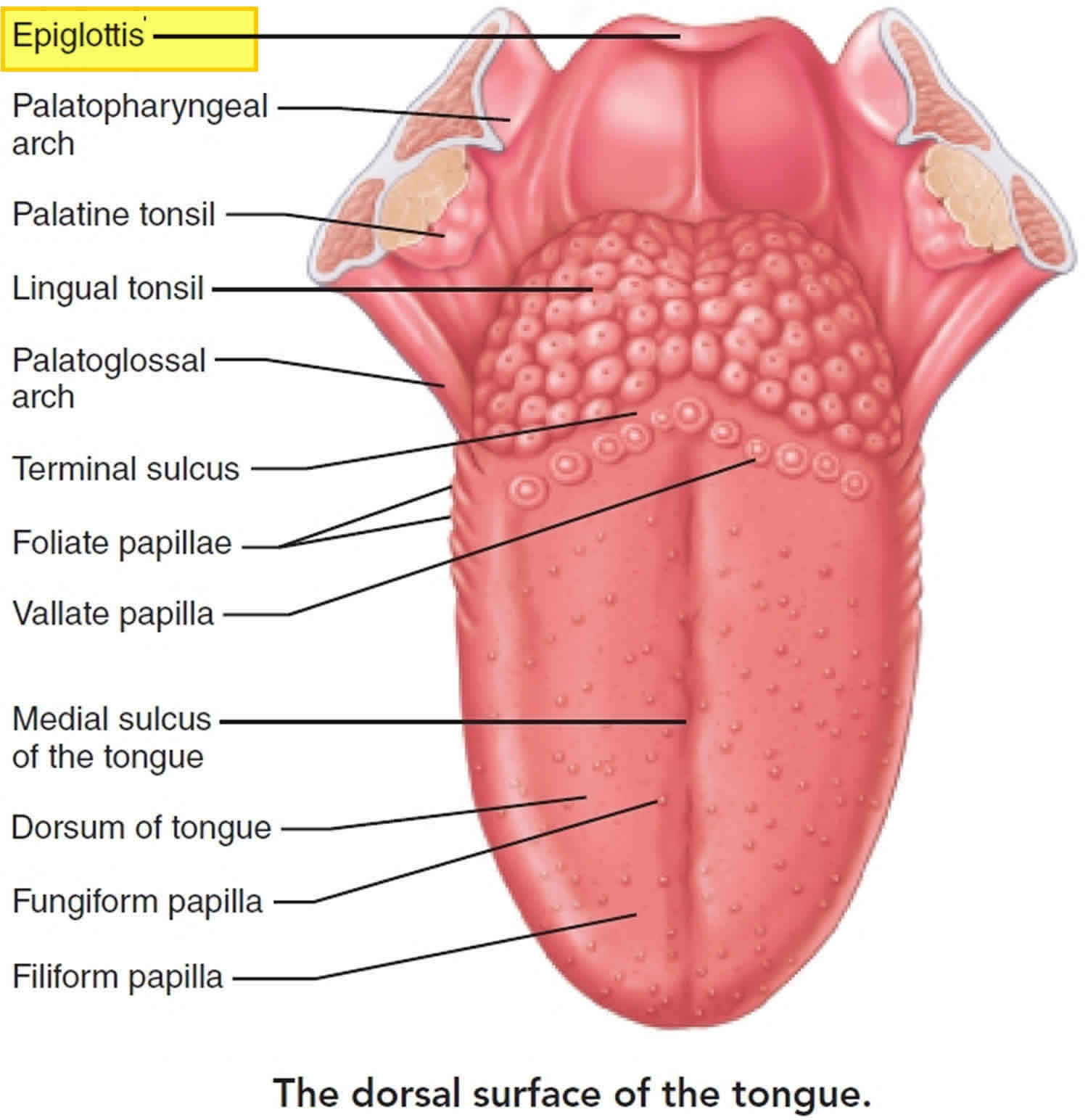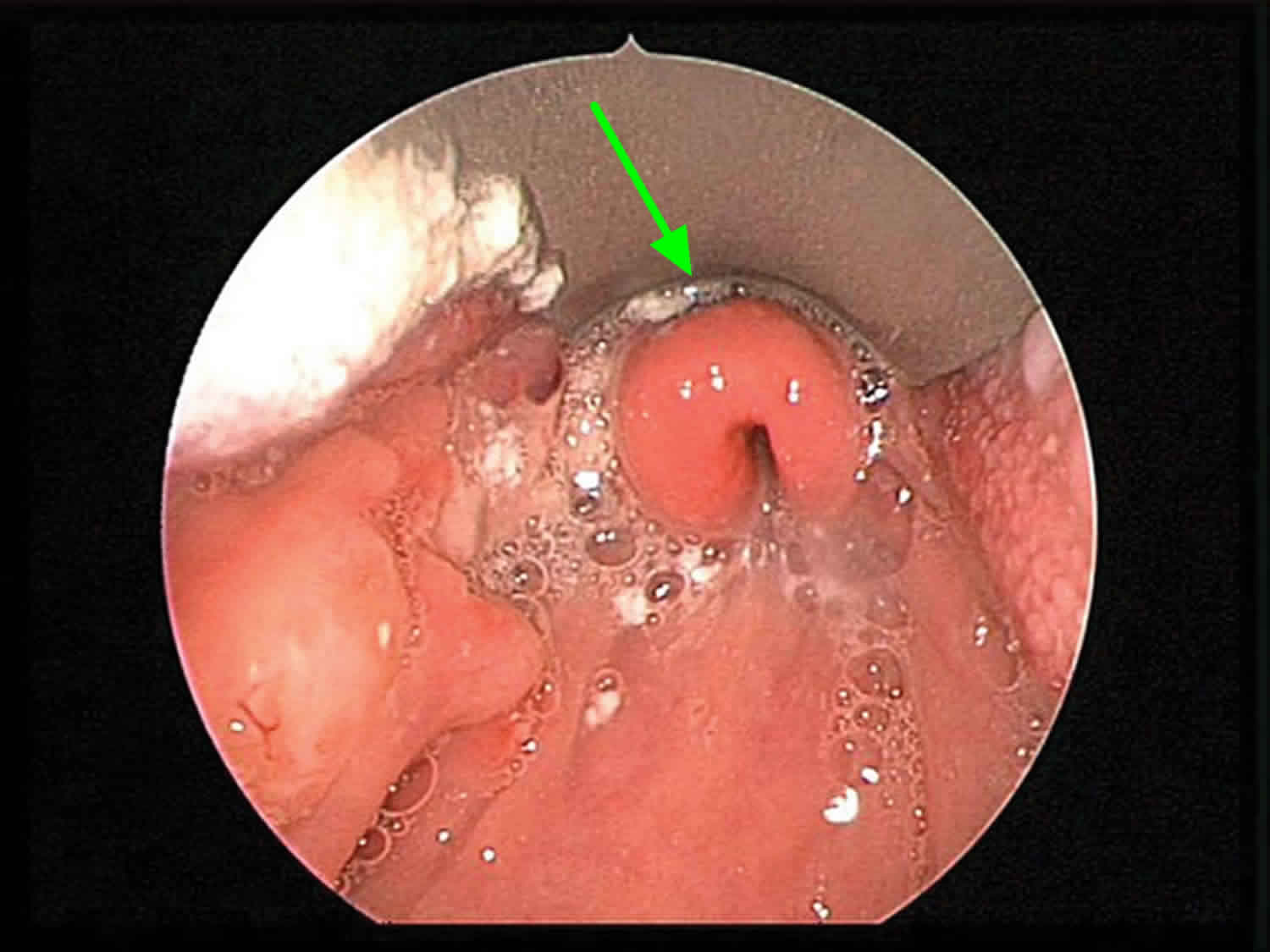What is epiglottis
The epiglottis is a leaf-shaped elastic cartilage flap behind your tongue (epiglottis means “upon the tongue”), which bends down to cover the glottis (opening) of the larynx each time you swallow. The epiglottis is a flap of elastic cartilage that sits beneath the tongue at the back of the throat. Its main function is to close over the windpipe (trachea) while you’re eating, to prevent food entering your airways. The epiglottis stalk attaches anteriorly to the internal aspect of the angle of the thyroid cartilage (Figure 1). From there, the epiglottis projects superoposteriorly and attaches to the posterior aspect of the tongue.
Figure 1. Epiglottis anatomy
Where is the epiglottis located
The epiglottis is located behind your tongue and it sits beneath the tongue at the back of the throat.
Figure 2. Epiglottis location
Epiglottis function
During swallowing, the entire larynx is pulled superiorly and anteriorly by the suprahyoid muscles, and the epiglottis tips inferiorly to cover and seal the laryngeal inlet. This action keeps food out of the lower respiratory tubes — so that food is not inhaled into your lungs. The entry into the larynx of anything other than air initiates the cough reflex, which expels the substance and prevents it from continuing into the lungs. By pulling anteriorly on the hyoid bone, suprahyoid muscles also widen the pharynx to receive the food.
The taste receptors occur in taste buds in the mucosa of the mouth and pharynx. The majority of the 10,000 or so taste buds are on the surface of the tongue; a few others occur on the epiglottis. The vagus nerve (cranial nerve 10) carries taste impulses from the few taste buds on the epiglottis and lower pharynx.
Epiglottitis
Epiglottitis is a potentially life-threatening inflammation and swelling of the epiglottis with the potential risk of fatal airway obstruction – blocking the flow of air into your lungs (see Figures 1 to 4) 1. Epiglottitis is often caused by an infection, but can also sometimes occur as a result of a throat injury. Epiglottitis can be fatal if the throat becomes completely blocked. But most people make a full recovery with appropriate treatment.
Acute epiglottitis is known to be potentially life-threatening because the special structure and anatomical location of the epiglottis (see Figures 1 to 4) make it prone to severe swelling (edema), which can lead to dyspnea (shortness of breath) and even suffocation, resulting in death 2. In most cases, acute epiglottitis is caused by infection. Effective management requires rapid diagnosis, airway management, and treatment of the causative agent.
Less common causes of acute epiglottitis include:
- other bacterial infections – such as streptococcus pneumoniae (a common cause of pneumonia)
- fungal infections – people with a weakened immune system are most at risk from these types of infection
- viral infections – such as the varicella zoster virus (the virus responsible for chickenpox) and the herpes simplex virus (the virus responsible for cold sores)
- trauma to the throat – such as a blow to the throat, or burning the throat by drinking very hot liquids
- smoking – particularly illegal drugs, such as cannabis or crack cocaine
Epiglottitis is a medical emergency. If you or someone you know suddenly has trouble breathing and swallowing, call your local emergency number for an ambulance or go to the nearest hospital emergency department. Try to keep the person quiet and upright, because this position may make it easier to breathe. Don’t try to examine the person’s throat yourself. This can make matters worse.
Epiglottitis causes
Epiglottitis is usually caused by epiglottis infection with Haemophilus influenzae type b (Hib) bacteria.
As well as epiglottitis, Haemophilus influenzae type b (Hib) can cause a number of serious infections, such as pneumonia and meningitis.
Haemophilus influenzae type b (Hib) spreads in the same way as the cold or flu virus. The Haemophilus influenzae type b (Hib) bacteria are in the tiny droplets of saliva and mucus propelled into the air when an infected person coughs or sneezes.
You catch Haemophilus influenzae type b (Hib) infection by breathing in these droplets or, if the droplets have landed on a surface or object, by touching this surface and then touching your face or mouth.
Less common causes of epiglottitis include:
- other bacterial infections – such as streptococcus pneumoniae (a common cause of pneumonia)
- fungal infections – people with a weakened immune system are most at risk from these types of infection
- viral infections – such as the varicella zoster virus (the virus responsible for chickenpox) and the herpes simplex virus (the virus responsible for cold sores)
- trauma to the throat – such as a blow to the throat, or burning the throat by drinking very hot liquids
- smoking – particularly illegal drugs, such as cannabis or crack cocaine
Haemophilus influenzae type b (Hib) vaccination
The most effective way to prevent your child getting epiglottitis is to make sure their vaccinations are up-to-date.
Children are particularly vulnerable to a Haemophilus influenzae type b (Hib) infection because they have an underdeveloped immune system.
Risk factors for epiglottitis
Certain factors increase the risk of developing epiglottitis, including:
- Being male. Epiglottitis affects more males than females.
- Having a weakened immune system. If your immune system has been weakened by illness or medication, you’re more susceptible to the bacterial infections that may cause epiglottitis.
- Lacking adequate vaccination. Delayed or skipped immunizations can leave a child vulnerable to Hib and increases the risk of epiglottitis.
Figure 3. Swollen epiglottis
Symptoms of epiglottitis
The symptoms of epiglottitis usually develop quickly and get rapidly worse, although they can develop over a few days in older children and adults.
Symptoms include:
- a severe sore throat
- difficulty and pain when swallowing
- difficulty breathing, which may improve when leaning forwards
- breathing that sounds abnormal and high-pitched (stridor)
- a high temperature (fever) of 100.4 °F (38 °C) or above
- irritability and restlessness
- muffled or hoarse voice
- drooling
The main symptoms of epiglottitis in young children are breathing difficulties, stridor and a hoarse voice.
In adults and older children, swallowing difficulties and drooling are the main symptoms.
Epiglottitis prevention
Haemophilus influenzae type b (Hib) vaccine
The most effective way to prevent your child getting epiglottitis is to make sure their vaccinations are up to date.
Children are particularly vulnerable to a Haemophilus influenzae type b (Hib) infection, because they have an underdeveloped immune system.
Children should receive their Haemophilus influenzae type b (Hib) as part of the 5 in 1 DTaP/IPV/Hib vaccine, which also protects against diphtheria, tetanus, whooping cough and polio.
Immunization with the Haemophilus influenzae type b (Hib) vaccine is an effective way to prevent epiglottitis caused by Haemophilus influenzae type b (Hib). Children should receive three doses of the vaccine: one at two months, one when they are three months and one when they are four months old. This is followed by an additional Hib/Men C “booster” vaccine at 12 months.
In the United States, children usually receive the vaccine in three or four doses:
- At 2 months
- At 4 months
- At 6 months if your child is being given the four-dose vaccine
- At 12 to 15 months
The Haemophilus influenzae type b (Hib) vaccine is generally not given to children older than age 5 or to adults because they’re less likely to develop Hib infection. But the Centers for Disease Control and Prevention recommends the vaccine for older children and adults whose immune systems have been weakened by:
- Sickle cell disease
- HIV/AIDS
- Spleen removal
- Chemotherapy
- Medications to prevent rejection of organ or bone marrow transplants
Haemophilus influenzae type b (Hib) vaccine side effects
- Allergic reaction. Seek immediate medical help if you have an allergic reaction. Though rare, an allergic reaction may cause difficulty breathing, wheezing, hives, weakness, a rapid heartbeat or dizziness within minutes or a few hours after the shot.
- Possible mild side effects. These include redness, warmth, swelling or pain at the injection site, and a fever.
Commonsense precautions
Of course, the Hib vaccine doesn’t offer guarantees. Immunized children have been known to develop epiglottitis — and other germs can cause epiglottitis, too. That’s where commonsense precautions come in:
- Don’t share personal items.
- Wash your hands frequently.
- Use an alcohol-based hand sanitizer if soap and water aren’t available.
Epiglottitis treatment
Epiglottitis is treated in hospital!
The first thing the medical team will do is secure the person’s airways to make sure they can breathe properly.
Securing the airways
An oxygen mask will be given to deliver highly concentrated oxygen to the person’s lungs.
If this does not work, a tube will be placed in the person’s mouth and pushed past their epiglottis into the windpipe. The tube will be connected to an oxygen supply.
In severe cases where there’s an urgent need to secure the airways, a small cut may be made in the neck at the front of the windpipe so a tube can be inserted. The tube is then connected to an oxygen supply.
This procedure is called a tracheostomy and it allows oxygen to enter the lungs while bypassing the epiglottis.
An emergency tracheostomy can be carried out using local anaesthetic or general anaesthetic.
Once the airways have been secured and the person is able to breathe unrestricted, a more comfortable and convenient way of assisting breathing may be found.
This is usually achieved by threading a tube through the nose and into the windpipe.
Fluids will be supplied through a drip into a vein until the person is able to swallow.
Once this has been achieved and the situation is thought to be safe, some tests may be carried out, such as:
- a fibreoptic laryngoscopy – a flexible tube with a camera attached to one end (laryngoscope) is used to examine the throat
- a throat swab – to test for any bacteria or viruses
- blood tests – to check the number of white blood cells (a high number indicates there may an infection) and identify any traces of bacteria or viruses in the blood
- an X-ray or a CT scan – sometimes used to check the level of swelling
Any underlying infection will be treated with a course of antibiotics.
With prompt treatment, most people recover from epiglottitis after about a week and are well enough to leave hospital after 5 to 7 days.
References- Chen C, Natarajan M, Bianchi D, Aue G, Powers JH. Acute Epiglottitis in the Immunocompromised Host: Case Report and Review of the Literature. Open Forum Infectious Diseases. 2018;5(3):ofy038. doi:10.1093/ofid/ofy038. https://www.ncbi.nlm.nih.gov/pmc/articles/PMC5846294/
- Pathological characteristics of the epiglottis relevant to acute epiglottitis. Sato S, Kuratomi Y, Inokuchi A. Auris Nasus Larynx. 2012 Oct; 39(5):507-11. https://www.ncbi.nlm.nih.gov/pubmed/22113103/










